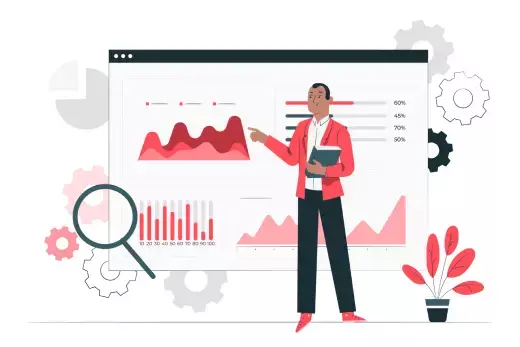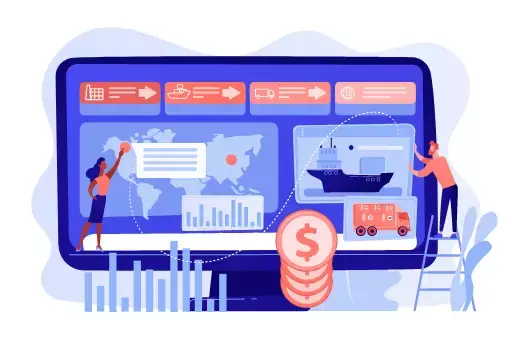Have any questions Submit an Inquiry

As they say, you cannot change, improve and achieve if you are not tracking and measuring your goals and KPIs, so Dashboards and Tools are very essential if a procurement organization wants to improve its efficiency and effectiveness. EmpoweringCPO offers various procurement dashboards and tools to effectively manage and facilitate performance. The below-listed image presents the different types of tools provided by EmpoweringCPO.
In the complex world of healthcare, procurement processes can often become mired in inefficiencies, leading to issues with contract management, decision-making, and data analysis.
Summarizes & tracks procurement organization KPI’s and status of different initiatives:

Acts as data source for all other procurement tools, Spend Analytics Dashboard helps in exploring data across multiple dimensions, tracks category level KPI’s; the process involves:

Tool presents and helps management team to prepare multi-year sourcing wave plan and estimate savings, tracks categories and data points like:

Ensures orders are placed only with the vendors that were shortlisted after the sourcing process and at the same price that was agreed, the tool prevents:

Classifies top vendors into – Leverage, Bottleneck, Routine, Strategic and Critical; helps in predicting probable supplier failures and facilitates:

Tracks upstream and downstream market drivers and provides macro level early warning, content is refreshed automatically and includes:

Tracks progress of supplier diversity program and total spend with diversity vendors, gives snapshot of the change, the diversity vendors are further classified into:

Sustainable Procurement Dashboard helps in identifying categories that can be re-sourced to sustainability goals; criteria used for identifying categories:
Enhance your decision-making capabilities of different procurement services with our tailored Category & Project Specific Dashboards like Tail Spend Management. In addition to our comprehensive standard dashboards listed above, we also support with customized dashboards to meet your specific category and project requirements. Take advantage of our expertise in dashboard design and implementation to unlock valuable insights and drive successful outcomes.
Efficiently track and analyze your legal expenditures to identify cost-saving opportunities and ensure optimal budget allocation. Access our comprehensive Legal Spend Analysis Dashboard for smarter financial decision-making.
View an example of our dynamic category dashboard, experience the benefit of visual presentation of Procurement Market Intelligence including category cost drivers, supplier landscape, price trends and many more insights. Take your category management to the next level
Identify potential cost-saving opportunities in your healthcare organization with our advanced Medical Consumables Cost Savings Analysis Dashboard. Analyze consumption patterns, optimize procurement strategies, and achieve significant savings without compromising quality of care.
Present the summary of your sourcing project to all the stakeholders, get buy-in and inputs from all of them to ensure successful implementation and drive result-oriented outcomes.
If you need to speak to us about a general query fill in the form below and we will call you back within the same working day.
These are quite recently the absolute most normal inquiries we get inquired.
A procurement dashboard is a visual representation of key procurement metrics and data that provide an at-a-glance view of procurement performance. It is a tool used by procurement professionals to track and monitor procurement activities, identify trends, and make informed decisions.
The importance of a procurement dashboard lies in its ability to enable procurement teams to monitor and evaluate their performance, pinpoint areas in need of improvement, and accomplish their objectives and key performance indicators (KPIs). By providing real-time access to data and metrics, a procurement dashboard facilitates data-driven decision-making, enhances supplier performance, and drives cost savings for the organization.
EmpoweringCPO provides a diverse range of procurement dashboards and tools that cater to the specific needs of organizations. From a procurement KPI dashboard that helps track and measure procurement performance, to a spend analytics dashboard that provides insights into spending patterns, EmpoweringCPO equips procurement professionals with powerful tools to make informed decisions. In addition, their opportunity assessment dashboard helps identify areas for improvement, while the compliance management tool and supplier risk management tool ensure compliance with regulations and minimize potential risks. These cutting-edge procurement dashboards and tools empower organizations to optimize their procurement processes and drive success.
A procurement KPI dashboard is a visual tool that displays key performance indicators (KPIs) for measuring and tracking procurement performance. It provides a comprehensive overview of the performance metrics that are important for the procurement function, enabling procurement professionals to monitor and evaluate their progress towards meeting their goals.
A spend analytics dashboard is a visual tool that provides insights into an organization’s spending patterns and helps procurement professionals make informed decisions. It allows organizations to track and analyze spending data across various categories, suppliers, departments, and time periods, providing a comprehensive view of their expenditure.
An opportunity assessment dashboard is a visual tool that helps procurement professionals identify areas of opportunity and improvement in their procurement processes. It allows organizations to evaluate their procurement practices and identify areas where they can improve efficiency, reduce costs, or optimize supplier performance.
A compliance management tool is a software application designed to help organizations manage and track their compliance with relevant laws, regulations, and industry standards. It enables procurement professionals to ensure that their procurement activities are in compliance with various rules and regulations, minimizing the risk of legal or regulatory violations.
A supplier risk management tool is a software application designed to help organizations identify, assess, and manage risks associated with their suppliers. It enables procurement professionals to evaluate supplier risks and take proactive measures to mitigate them, minimizing the potential for supply chain disruptions and other negative impacts on the organization.
At EmpoweringCPO, we have the expertise to develop spend dashboards and tools using various technologies, based on the specific preferences of our clients. We use top-rated Business Intelligence and Dashboard platforms that are recognized as Leaders in their respective quadrants, ensuring that our clients receive the best user experience and insights possible. Our goal is to create highly customized and effective spend dashboards and tools that meet the unique needs of each client and help them achieve their procurement objectives.
EmpoweringCPO’s team of experienced sourcing professionals, focus on outstanding client service, and ability to achieve results sets us apart from other providers.
Spend analysis is the process of collecting, cleansing, classifying, and analyzing an organization’s spend data to gain insights into its procurement activities. It involves identifying and categorizing all the purchases made by an organization, including direct and indirect spend, and analyzing the data to identify patterns, trends, and opportunities for cost savings and process improvements.
Taxonomy preparation is the process of defining and creating a standardized classification system for spend data in a spend analysis project. It involves establishing a consistent set of categories and subcategories for spend data that can be used to analyze procurement activities across an organization.
Data classification is the process of categorizing data into different groups or classes based on certain characteristics, such as its content, sensitivity, or usage. It involves organizing and labeling data according to a predefined set of categories or criteria to facilitate its management, protection, and sharing.
Data analysis is the process of inspecting, cleaning, transforming, and modeling data to extract meaningful insights and information. It involves using statistical and computational methods to identify patterns, trends, and relationships in data, and to draw conclusions and make informed decisions based on the analysis.
An interactive visual dashboard is a graphical user interface that displays real-time data in a way that allows users to explore and analyze the data interactively. It typically presents data using visual elements such as charts, graphs, and tables, and enables users to interact with the data by selecting different variables, adjusting filters, and drilling down into the details.
A sourcing roadmap or implementation plan is a strategic plan that outlines the steps and actions necessary to implement a sourcing strategy or initiative. It is a detailed roadmap that identifies the specific actions required to achieve the goals and objectives of the sourcing strategy, and provides a timeline and budget for the implementation.
The outcome of a strategic sourcing project is the successful implementation of a sourcing strategy that achieves the desired goals and objectives of the project. This typically includes a range of outcomes, including cost savings, improved supplier relationships, increased efficiencies, and enhanced product or service quality.
Spend under management is a metric used by procurement teams to track the percentage of an organization’s total spend that is being actively managed by the procurement function. It refers to the portion of an organization’s spend that is being actively monitored, analyzed, and controlled by the procurement team through strategic sourcing, contract management, and supplier relationship management.
CSR (Corporate Social Responsibility) goals in procurement are objectives set by organizations to ensure that their procurement practices align with their values and commitment to sustainability, ethical business practices, and social responsibility.
Stakeholder metrics in procurement are a set of key performance indicators (KPIs) that are used to measure and evaluate the performance of procurement activities and their impact on various stakeholders, both internal and external to the organization.

The EmpoweringCPO dashboard, as the name suggests, this tool summarizes the performance of the procurement organization in terms of different initiatives undertaken, some of which are listed below:
The above-listed initiatives are presented in form of Key Performance Indicators (KPI). They can be drilled to multiple levels to provide insights to CPO and senior management. The source of data for the procurement reporting dashboard is all the other tools listed here.
The spend tool is considered the core tool because it holds most of the raw data and acts as a source for most of the other tools presented here. The objective of this tool is to clean, collate, classify and present the organization’s spending data from various systems as per the pre-decided organization taxonomy. This taxonomy is unique for each organization and varies from 3 to 7 different layers depending on the complexity of the organization. The last level of the taxonomy represents a unique set of suppliers with unique core competencies and ideally, should represent a set of participants for a unique RFP.
The spend analysis process is divided into the following steps:
EmpoweringCPO is capable of developing spend dashboards and tools using multiple technologies as per client preference. Business Intelligence and Dashboard platforms classified in Leaders quadrants are adopted so as to present the best user experience and insights. The spend analytics dashboard helps in exploring data across multiple dimensions and allows category managers and CPOs to remain on top of their categories and KPIs.
Opportunity Assessment as a tool usually goes along with the spending tool and in fact, at times is considered complementary to the latter. The objective of this tool is to keep track of all the major categories with data points like:
Opportunity Assessment as a tool allows the management team to prepare a multi-year sourcing wave plan and estimate savings that may be possible for the following years. For projecting savings and identifying opportunities, EmpoweringCPO adopts its proven approach of reviewing each category on two broad parameters:
Both these parameters are again subdivided into multiple factors as presented below:
| Ease of Sourcing & Implementation | Savings Potential |
| Availability & quality of data | Potential to leverage |
| Degree of customization in design | Level of commoditization |
| Availability of suppliers / geographical barriers | Competition in the market |
| Number of incumbent suppliers | Demand – Supply Scenario |
| Time to qualify suppliers/switching risk | Current compliance mechanism |
| Organizational sensitivity / contractual complexity | Time since the last RFP |
Compliance management is very critical as otherwise the procurement organization may run into a scenario where there is a huge gap between realized savings and reported savings. Many procurement functions estimate large savings numbers when contracts are signed. They also invest significant time and effort in negotiating contracts for necessary goods and services, only to have a third or more of their purchasing dollars flow outside those deals. Some of the obvious fall-outs of non-compliance and maverick purchases are:
As compared to the current contract that was finalized after the sourcing process, the tool helps in tracking:
The objective of this tool is to ensure that the orders are placed only with the vendors that were shortlisted after the sourcing process and at the same price that was agreed upon and negotiated during and after the strategic sourcing process.
The scoring is conducted by EmpoweringCPO consultants along with a small group of stakeholders and category managers in the client organization. This process helps in segregating vendors into multiple buckets
Thorough research is conducted for the vendors which are classified as critical and strategic. The objective is to collect as much information about these vendors as possible so as to help in predicting probable failures. This exercise also helps in preparing a mitigation plan if any failure was to occur. Along with the vendor performance dashboard, this tool is structured to promote collaboration during the scoring process as well as supports version tracking.
This tool helps in predicting and preparing for the probability of variables that may adversely or favorably affect the supply chain. The process starts with evaluating the top 20% of vendors and scoring them on two broad parameters listed below:
| Business Impact | Supply Risk |
| Total cost (spend volume) | Financial health, logistics, Inventory, and lead time |
| Impact on customer value | Entry barrier, intellectual property |
| Impact on product differentiation | Pressure from substitute |
| Impact on the performance of the company | Bargaining power |
| Impact with reference to safety/ Governmental/ Industry Regulations | Offshore supply |
| Impact on Technological status or ranking | Availability of suppliers |
The category management dashboard helps in tracking various upstream and downstream market drivers of a commodity. The objective of the tool is to help predict the changes in the marketplace so that the procurement organization is better prepared for all eventualities. The tool is in form of a dashboard created to present the following content, all different types of drivers and industry snapshots on the same screen:
Most of the drivers, indices, and price trends are updated and refreshed automatically every month. Parameters like consumption pattern, application and use of the commodity, total market size, cost drivers/components, and other parameters are refreshed less frequently. Broadly the parameters are divided into some which are dynamic and some which are relatively static.
The objective of this dashboard is to provide macro-level early warning signals to category managers so as to help them prepare and manage their categories proactively.
The Supplier diversity dashboard helps in tracking the total spending of the organization with diverse vendors. It gives a snapshot of the change as compared to the total spending as compared to what it was in the previous month or year. This tool is closely linked with the spending tool and a column is added that acts as an identifier to present the type of diverse vendor. The diversity is classified as:
Thus this dashboard acts as a very powerful tool to help companies achieve their Corporate Social Responsibility (CSR) goals.
The sustainable procurement dashboard works closely with the spending tool. It helps in identifying categories that can be re-sourced and thus results in improved sustainability goals for the organization. The criteria used for identifying these categories are:
Compliance management is very critical as otherwise the procurement organization may run into a scenario where there is a huge gap between realized savings and reported savings. Many procurement functions estimate large savings numbers when contracts are signed. They also invest significant time and effort in negotiating contracts for necessary goods and services, only to have a third or more of their purchasing dollars flow outside those deals. Some of the obvious fall-outs of non-compliance and maverick purchases are:
As compared to the current contract that was finalized after the sourcing process, the tool helps in tracking:
The objective of this tool is to ensure that the orders are placed only with the vendors that were shortlisted after the sourcing process and at the same price that was agreed upon and negotiated during and after the strategic sourcing process.